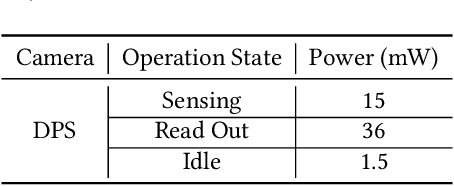Saavan Patel
Distributed On-Sensor Compute System for AR/VR Devices: A Semi-Analytical Simulation Framework for Power Estimation
Mar 14, 2022



Abstract:Augmented Reality/Virtual Reality (AR/VR) glasses are widely foreseen as the next generation computing platform. AR/VR glasses are a complex "system of systems" which must satisfy stringent form factor, computing-, power- and thermal- requirements. In this paper, we will show that a novel distributed on-sensor compute architecture, coupled with new semiconductor technologies (such as dense 3D-IC interconnects and Spin-Transfer Torque Magneto Random Access Memory, STT-MRAM) and, most importantly, a full hardware-software co-optimization are the solutions to achieve attractive and socially acceptable AR/VR glasses. To this end, we developed a semi-analytical simulation framework to estimate the power consumption of novel AR/VR distributed on-sensor computing architectures. The model allows the optimization of the main technological features of the system modules, as well as the computer-vision algorithm partition strategy across the distributed compute architecture. We show that, in the case of the compute-intensive machine learning based Hand Tracking algorithm, the distributed on-sensor compute architecture can reduce the system power consumption compared to a centralized system, with the additional benefits in terms of latency and privacy.
Combining Learned Representations for Combinatorial Optimization
Sep 09, 2019



Abstract:We propose a new approach to combine Restricted Boltzmann Machines (RBMs) that can be used to solve combinatorial optimization problems. This allows synthesis of larger models from smaller RBMs that have been pretrained, thus effectively bypassing the problem of learning in large RBMs, and creating a system able to model a large, complex multi-modal space. We validate this approach by using learned representations to create ``invertible boolean logic'', where we can use Markov chain Monte Carlo (MCMC) approaches to find the solution to large scale boolean satisfiability problems and show viability towards other combinatorial optimization problems. Using this method, we are able to solve 64 bit addition based problems, as well as factorize 16 bit numbers. We find that these combined representations can provide a more accurate result for the same sample size as compared to a fully trained model.
 Add to Chrome
Add to Chrome Add to Firefox
Add to Firefox Add to Edge
Add to Edge